Always in search of adventure, Stacey has handcrafted her dream life by taking her home and office on the road. She loves making a morning cup of coffee with a new view, having deep conversations with friends and leaving her plans open-ended so she can indulge her spontaneity.
Traveling with Pets
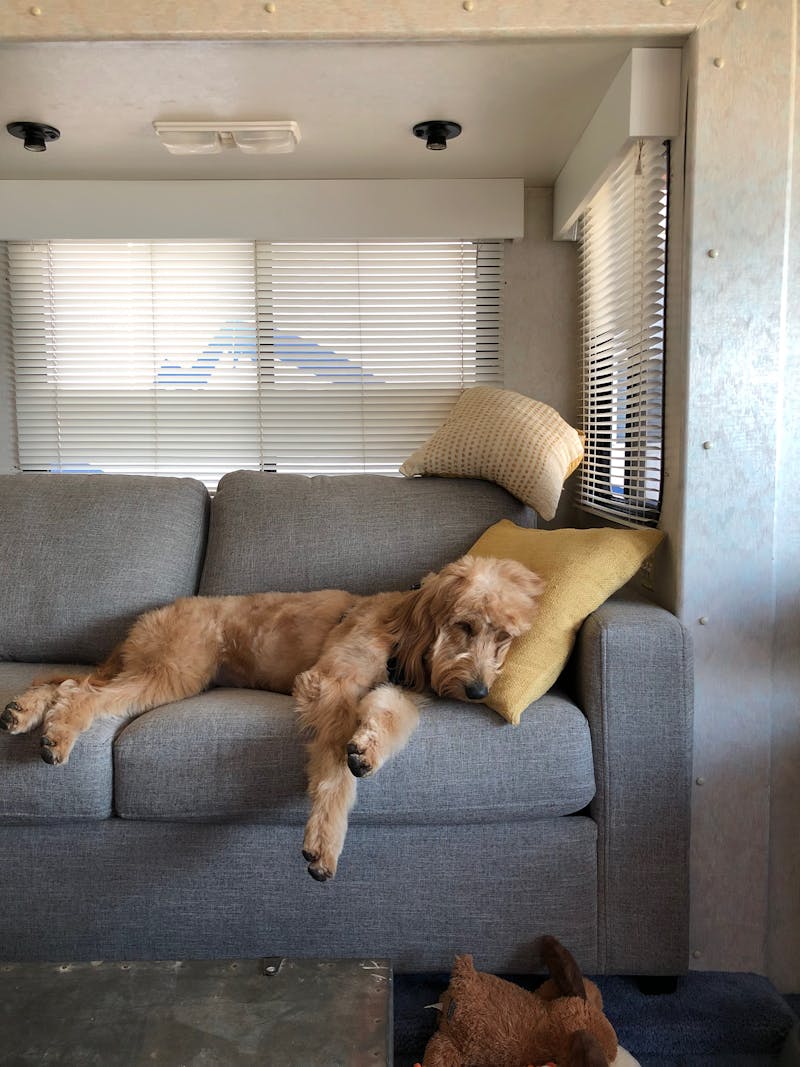
Love the idea of extended road trips but hate the thought of leaving the non-human members of your family behind? Don’t fret. It is possible to RV with pets. Below, three veteran RVers tell us about the tips, tricks and accommodations they’ve learned for bringing their pets on the road.

Stacey Powers with Jasper the fish and Scootz the snail
I have a fish named Jasper and a snail named Scootz. Keeping a fish and snail happy is pretty easy. I change their water completely every two weeks, and do small water changes every couple of days. I feed the fish twice a day and the snail just eats whatever is at the bottom of the tank. I also give them a new plant every couple of months to keep things fresh and exciting inside their water world. If it’s super hot out, I will add an ice cube to their water or bring them along with me in the truck and run some air conditioning to keep them cool on hot days. But I like to think that the ever-changing view out their window is what makes them the most happy.
My best travel tip would be to have courage and figure out a setup that works for you. I actually won Jasper at the fair and decided I would make it work. If you have a pet you want to bring with you in your RV, take time to figure out what will work for you and your animal.
I hate to admit this, but my first fish actually died. Everything about the setup had been working great for six months, until one day I was rushing out to meet a friend for surfing and hurriedly hung the bowl on the wall, without double checking if it was secure. I had been using four Command strips to attach the bowl to the wall, thinking it was strong enough to hold. But when I came back from surfing, the fish was on my couch. I was traumatized. I gave up on the idea of having another fish because I feared the same thing would happen.
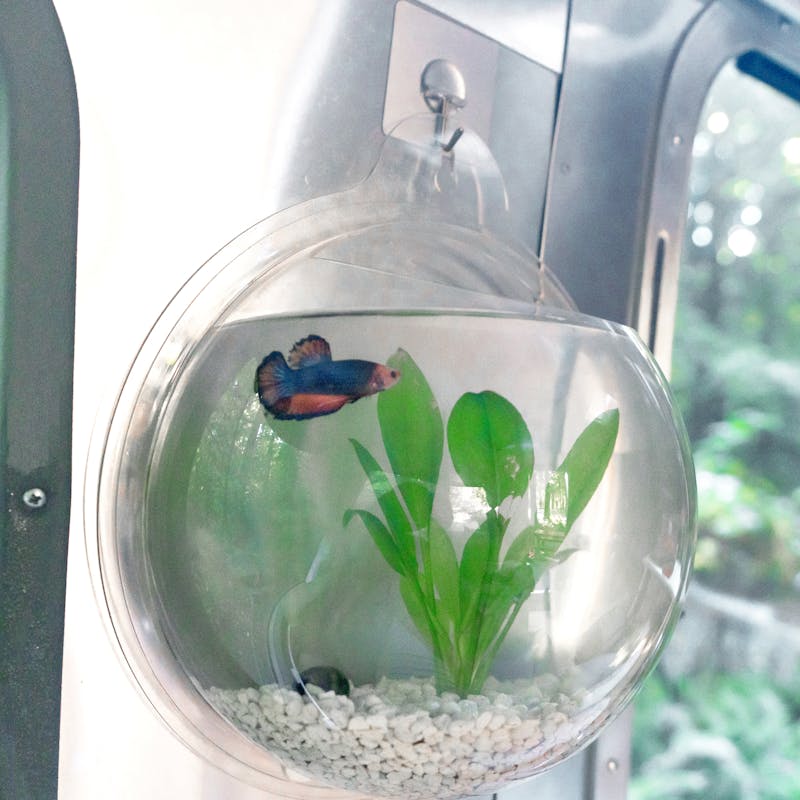
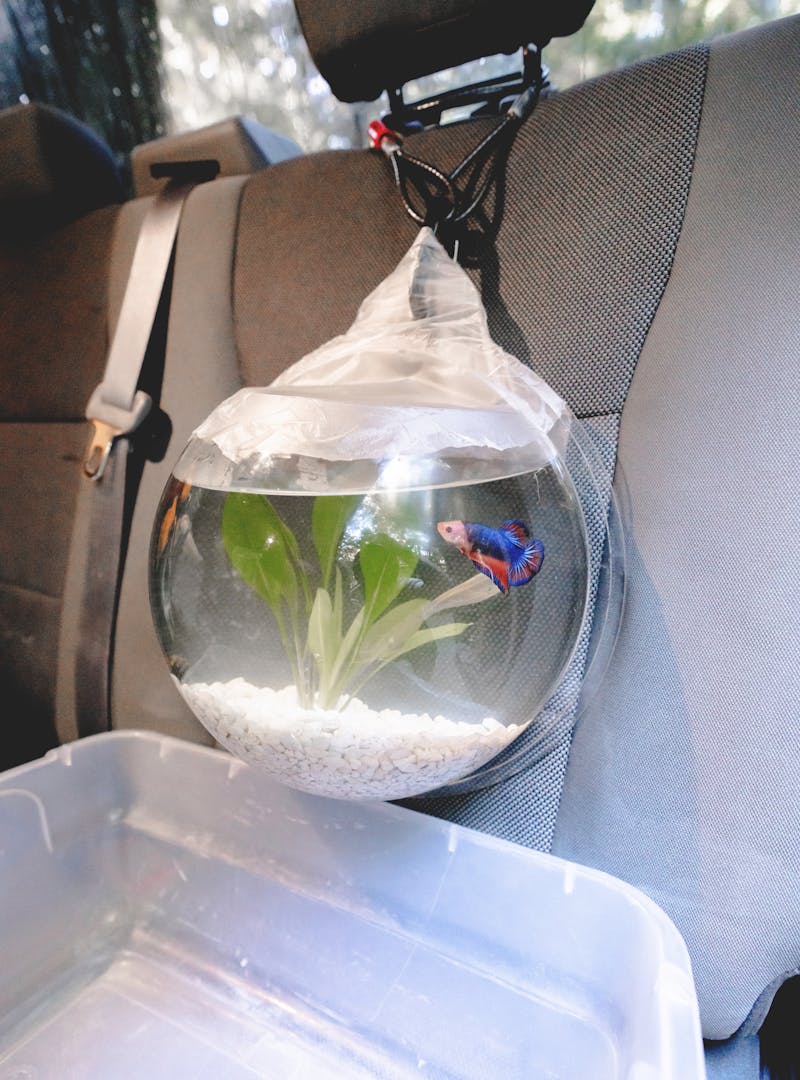
When Jasper came into my life, I called Airstream to ask about putting a screw in the wall to secure the bowl. They advised me not to. So I did more research about heavy-duty wall mounts that don’t require drilling, and I came across hooks that can hold up to 30lbs. I’ve been using them now for eight months and everything is super secure and working out great.
When I’m driving, I hang them from a head rest using a bike lock rope and a carabiner. The water tends to splash around a lot, so I place a container underneath to prevent any fishbowl water getting on my seats. I also cover the bowl with cling wrap and poke holes in it for air.
I absolutely love having the fish and snail on my wall to look at. They are my favorite things I’ve brought to my Airstream. Although I do get some funny looks when people ask me if I’m traveling with pets… No one else ever has a fish and a snail in their RV!

Jeff Shipley with Andie the Goldendoodle
Jeffrey loves life’s contrasts: rustic vs. modern, old vs. new, thinking vs. feeling. He travels the world with his keen sense of joy and his partner, Darren, and together they find inspiration around every corner.
Photo courtesy of Melissa Kilner
My partner Darren and I have one very cute, very spoiled Goldendoodle named Andie.
All Andie really needs is a sofa and a few throw pillows to smash as she sprawls out, and she’s a happy camper. But she also loves to have a little perch so she can see out when we’re driving. She climbs right up on the engine cover for a view of the road from time to time. (And if anything is in the way of her perch, she’s not happy about it.) When we’re not on the move, we give her ample play time, and try to take breaks during long hauls. If we can at least take her for a quick walk during pit stops, she doesn’t get as stir-crazy.
It’s important for pups to have a safe place in any RV. Andie loves curling up in her crate when it’s bedtime or when we need to leave her behind for a bit. It also keeps her from barking when we’re not at camp. We always make sure we pack a few of her favorites toys so she has some familiar comforts from home. And we bring lots of chew-chews to keep her entertained and busy when needed. We call it her “tablet time.”
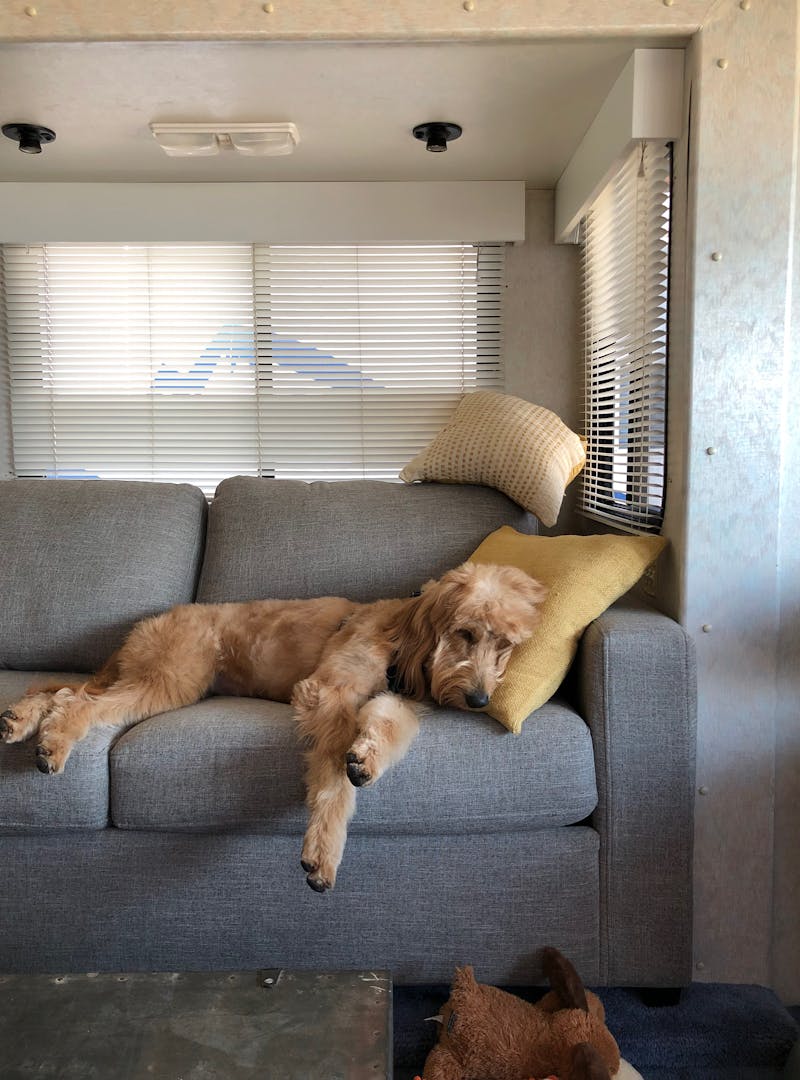

When we’re at camp, it’s easy for Andie to get excited about her outdoor freedom–she once knocked over a small child in a fit of love and kisses. We always make sure we put a leash and harness on her, both to keep her and others safe. (Local squirrels included.)
One thing we tried recently was instituting camp borders. We were camping with our family and some friends in California and there were lots of kids and dogs running around. To prevent drama between all the dogs, my mom suggested we treat the space in front of each of our camps as our own dog’s domain. It worked brilliantly. Everyone kept their puppers in their own camp and it helped keep everything under control.

Two important tips, we’ve learned the hard way. First, don’t let your dog swim too late in the day. Sure, you want to throw the ball into the lake one last time, but if it’s getting dark, you may find yourself with a wet, stinky dog in the RV all night. No thank you.
Second, plan for doggy meals. Andie doesn’t have set meal times, and while she doesn’t mind grazing at home, it’s trickier on the road. She won’t eat if we’re driving, and she’ll only eat when we’re around. So to make sure she’s actually eating, we now build some time into our travel schedule instead of rushing to just get to our destination. Andie brings so much to our lives, we want to make sure she’s getting all the food, love and breaks she needs.

Chiara Martinelli with Ñime the cat
Chiara is a proud cat lady, living and traveling full-time in a '90 camper. She enjoys a simple life, surrounded by nature, chasing spring, writing and photography.
I take my cat Ñime with me on all my travels. When we’re en route, we’ll only drive for two or three hours before stopping to give Ñime a break and a walk outside. In summer, we travel early in the morning or later in the day to avoid intense midday heat.
It took some time for Ñime to get used to traveling, but she wound up loving it. At first, we took her only very short distances in the RV. We closed all the curtains and avoided busy roads to keep noise and visual stimulation to a minimum. I stayed in the back with her to make sure she felt okay as we got on the road.
Initially, she meowed a lot and I could tell she was on high alert. Gradually, she began to relax, and when she began to sleep on our little journeys, we knew she was ready to travel. Now, she even enjoys looking out the windows when we’re in motion and loud noises don’t faze her at all. Sometimes, she even lays down on the dashboard and serves as our co-pilot.
Personally, we let her roam free in the camper, but we also know people who prefer to use a cat carrier for safety. If your cat is mischievous or energetic, it may be better to keep them secure while your RV is in motion. Just remember to leave fresh water and food inside the carrier. =
When we’re parked, we like to let Ñime roam free a bit, within the realm of safety. Early on in our travels together, she had a run-in with a scooter that left her a bit scratched up and missing a tooth. Now, when we’re in a new place, we make sure to walk her on a leash until we can be sure there are no potential dangers around. It took her some time to get used to the leash, but it’s worth it to know she’s safe. When we pick places to stop or camp, we put Ñime’s welfare as our top priority, preferring to park away from busy roads or other campers with dogs.
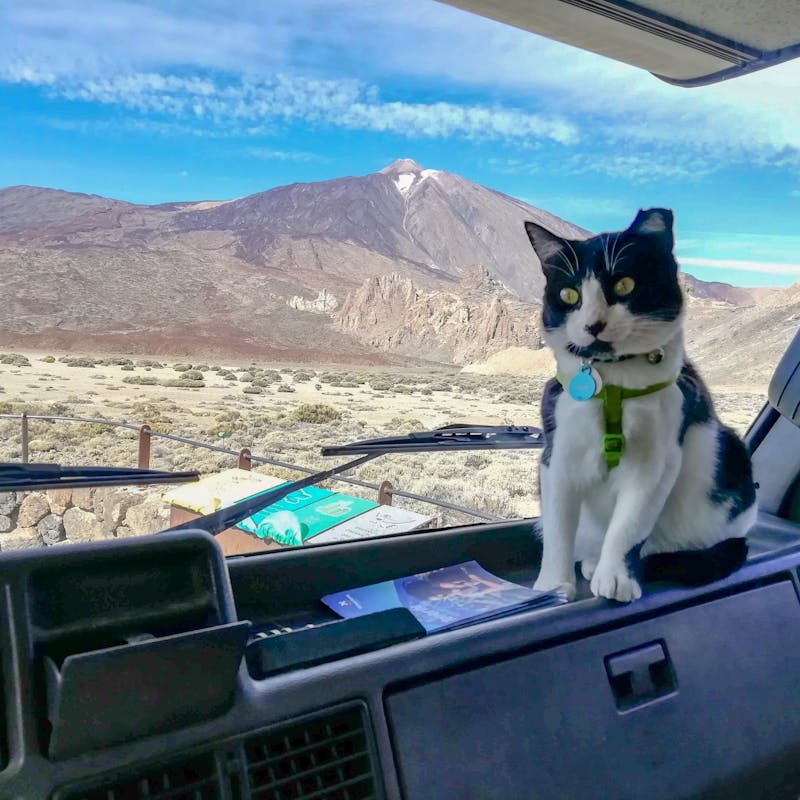
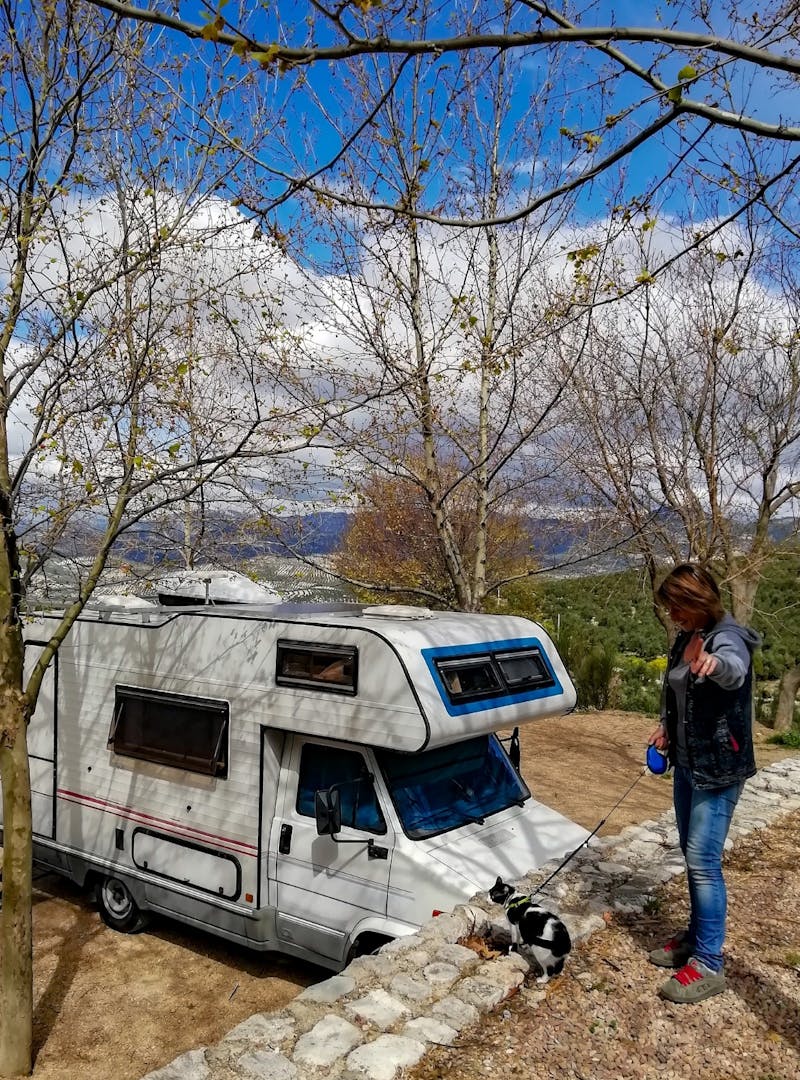
We’re also looking into a GPS tracking collar for her to allow her a bit more freedom to roam. Once, she disappeared over night, only reappearing the next day. Another time, she wandered into an empty RV and got stuck until we found her and freed her. Cats are curious by nature, but it would give us better peace of mind to know we can find her at any given moment.
Everything we know about RVing with cats we’ve learned by trial and error. We didn’t know anyone else traveling with cats--although since then, we’ve learned of various internet communities that address this exact subject. The Catexplorer podcast is a valuable source of support for anyone thinking about taking their kitty on the road.
The most important thing to keep in mind is your responsibility to your pet. Your cat’s welfare should always come first. If you leave your pet alone in your camper, don’t stay away for too long, especially in the warmer months. Take your cat for walks at least three times a day, especially if you’re not comfortable letting them roam freely. We’ve found that Ñime is happiest when we take her out for at least 30 minutes at a time. But when she’s happy, we’re all happy, and having her with us on the road is worth the extra planning and preparation.
Feeling inspired? Here’s how to get started traveling with your own pet:
Pave your own path. Lots of people travel with their dogs, but what if you have a pet you haven’t seen on the road yet? It can still work. Like Stacey Powers, get creative looking for ways to make it work. Small animals that live in tanks or cages–like hamsters, fish, turtles and frogs– can travel with you as long as their living quarters are secure while you’re in motion, and that may take some troubleshooting before you hit the road. Slightly larger pets–guinea pigs, rabbits, ferrets and the like–may be comfortable on the loose inside your RV, but we recommend keeping them indoors at all times. You never know what kinds of local animals have been waiting nearby for an easy meal. And as for big animals–service ponies, goats, potbelly pigs, etc.–well, if you’ve pulled this off, we’d love to hear your tips.
Treat pets like big babies. Just like human children, travel runs smoother if you put your pets’ needs first. You already know that your pup needs regular potty stops and mealtimes, but there may be some new quirks that aren’t apparent until you hit the road. We’ve heard about cats that won’t use the litter box unless the RV is settled and parked for a few hours, or dogs who don’t like to eat when the RV is in motion. Even if your fluffy little friend isn’t crying or barking, regularly-scheduled stops, meals and play time will help ensure they’re taking care of their basic needs in an environment filled with new sights, sounds and smells. In an attempt to please you, little Fluffy or Fido may go with the flow to the detriment of their own well-being. It’s up to you to be the one in charge.
Keep up on doctor visits. New environments can mean new potential hazards or challenges. For instance, coming and going in and out of your RV could track in new bugs—including fleas— even if your pet stays indoors. Coming into contact with other animals at RV parks could expose pets to germs they hadn’t previously encountered. And even the most well-vaccinated animal could find that local pollen in the air sets off a bout of allergies. So make sure your small friend is up to date on their immunizations and has a clean bill of health from a veterinarian before you hit the road.
Related Stories
Find Your Perfect RV
Whether you're new to the world of RVing or you're ready to narrow your search, we're here to help you sort through it all and find the RV that's right for you. Explore RVs based off of your lifestyle and the features important to you.



